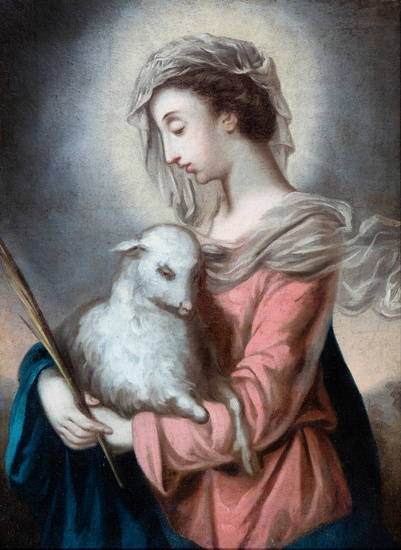Escuela española, s.XVII-XVIII
Spanish school of the 17th-18th century.
"Saint Agnes".
Oil on canvas. Relined.
Measurements: 64 x 49 cm 78 x 62 cm (frame).
In this work St. Agnes is represented as a young woman, holding in her arms a lamb (her main iconographic attribute, symbol of her purity) and the palm of martyrdom. The brushstroke, loose and of great mastery and precision, denotes a rapid and skilful execution, as can be clearly seen in the young woman's hair and the lamb's fur.
The name of St Agnes is taken from the Greek adjective "agné", meaning pure, chaste. The Romans, on the other hand, linked it with the Latin noun "agnus" (lamb), although there is no etymological connection. The legend of the saint derives from this popular etymology. It has been thought that such a name could be a symbol (virgo casta) rather than a real person, especially since the historical existence of St. Agnes is doubtful. At first there were two different traditions referring to two martyrs of the same name, which were later confused. According to St. Ambrose and St. Damasus, Agnes was a girl martyred at the age of twelve and beheaded. Her martyrdom would have occurred around 305, during the persecution of Diocletian. The Greek tradition, which is different, concerns an adult virgin. According to Basil's Menologion, Agnes would have refused to offer sacrifices to the gods. The two traditions, Latin and Greek, soon merged and were enriched with new legendary features, such as the miracle of the hair and the mantle, which was popularised by the Golden Legend. When the son of a prefect fell in love with her, Agnes rejected him, and the suitor fell ill with grief. Her father, the prefect, summoned her to court, and unable to force her to marry his son, left her to choose between making a sacrifice to the gods or dishonour. Taken naked to a brothel, her hair instantly grew long and covered her body. As if that hair was not enough, an angel wrapped her in a white cloak. She is the first saint to be endowed with an attribute (6th century). Her main iconographic symbol is the white lamb, symbol of her purity. The lamb is not only an allusion to her name. It is also a reminder of the vision of her parents, who, eight days after her death, reportedly saw their daughter appear with a lamb at her right hand. She is also recognisable by the burning bonfire whose flames move away without even touching her, by the sword, the instrument of torture, and by the palm of martyrdom.
Reentelado.
View it on
Sale price
Estimate
Time, Location
Auction House
Spanish school of the 17th-18th century.
"Saint Agnes".
Oil on canvas. Relined.
Measurements: 64 x 49 cm 78 x 62 cm (frame).
In this work St. Agnes is represented as a young woman, holding in her arms a lamb (her main iconographic attribute, symbol of her purity) and the palm of martyrdom. The brushstroke, loose and of great mastery and precision, denotes a rapid and skilful execution, as can be clearly seen in the young woman's hair and the lamb's fur.
The name of St Agnes is taken from the Greek adjective "agné", meaning pure, chaste. The Romans, on the other hand, linked it with the Latin noun "agnus" (lamb), although there is no etymological connection. The legend of the saint derives from this popular etymology. It has been thought that such a name could be a symbol (virgo casta) rather than a real person, especially since the historical existence of St. Agnes is doubtful. At first there were two different traditions referring to two martyrs of the same name, which were later confused. According to St. Ambrose and St. Damasus, Agnes was a girl martyred at the age of twelve and beheaded. Her martyrdom would have occurred around 305, during the persecution of Diocletian. The Greek tradition, which is different, concerns an adult virgin. According to Basil's Menologion, Agnes would have refused to offer sacrifices to the gods. The two traditions, Latin and Greek, soon merged and were enriched with new legendary features, such as the miracle of the hair and the mantle, which was popularised by the Golden Legend. When the son of a prefect fell in love with her, Agnes rejected him, and the suitor fell ill with grief. Her father, the prefect, summoned her to court, and unable to force her to marry his son, left her to choose between making a sacrifice to the gods or dishonour. Taken naked to a brothel, her hair instantly grew long and covered her body. As if that hair was not enough, an angel wrapped her in a white cloak. She is the first saint to be endowed with an attribute (6th century). Her main iconographic symbol is the white lamb, symbol of her purity. The lamb is not only an allusion to her name. It is also a reminder of the vision of her parents, who, eight days after her death, reportedly saw their daughter appear with a lamb at her right hand. She is also recognisable by the burning bonfire whose flames move away without even touching her, by the sword, the instrument of torture, and by the palm of martyrdom.
Reentelado.



